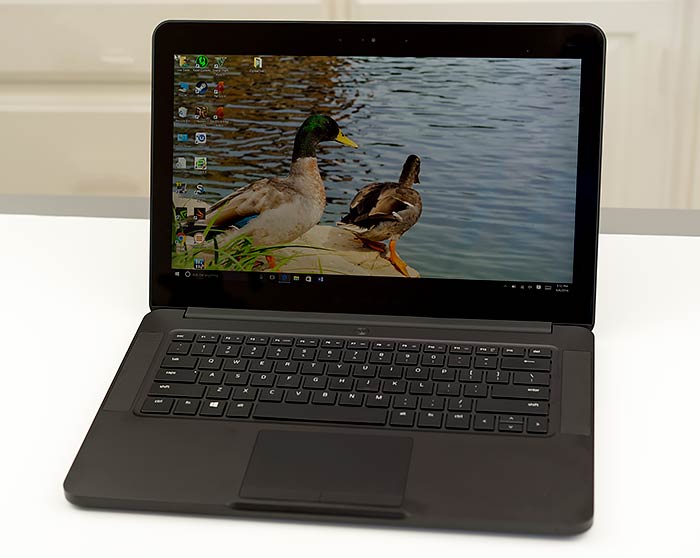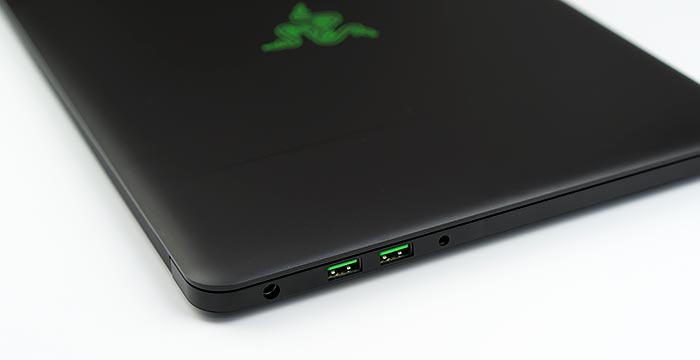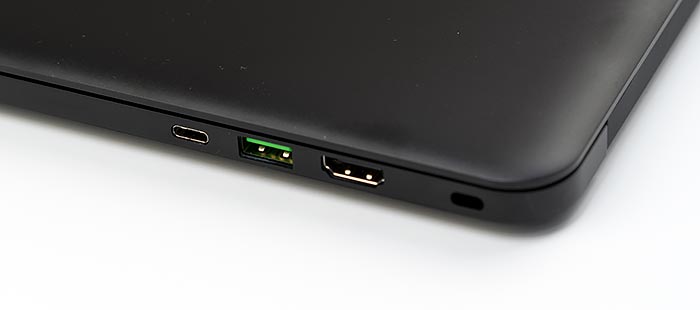|
The Razer Blade has been synonymous with cutting edge technology and gaming prowess since the line's 2012 launch. Razer makes excellent gaming oriented peripherals, and their Blade laptops are boutique gaming laptops that look stately enough to take into a meeting (particularly if you turn off the lighted green Razer snake logo on the lid). The 2016 model (released May 2016 and refreshed with new NVDIA GTX 1060 graphics in late 2016) is the evolution of the line, and much remains the same as the last generation, including the portable and slim 14" form factor, high end dedicated graphics and the same QHD+ Sharp IGZO vibrant touch screen. Even better, for late 2016 Razer has brought back the full HD matte display option, with a lower price tag and better contrast than the QHD+ model.
What's changed in this Intel quad core powerhouse? Razer has updated the Chroma keyboard, reduced weight, moved from 4th to 6th generation Intel CPUs and improved cooling. If you own the 2015 model, that's not likely enough to entice you to upgrade, but the huge jump in graphics performance with the NVIDIA Pascal 10 Series GPU might be enough. Razer has dropped the price ($1,799-$2,199) several hundred dollars from previous generations, making this expensive laptop a wee bit more attainable. It's in the same price range as a similarly equipped Dell XPS 15 and considerably less expensive than the 2016 15" MacBook Pro with tepid AMD dedicated graphics. It's still more expensive than MSI's slim and light 15.6" GS63VR Stealth Pro and 14" GS40 Phantom Pro, but the price divide for a similarly configured laptop is no longer that great.
Specs at a Glance
This is a very thin and light 14" gaming and pro apps laptop that weighs just 4.16 to 4.3 lbs. and is 0.7" thick. It's portable enough to be a great travel machine, but it has the horsepower of a much larger gaming laptop. It's finished in matte black aluminum and ships with the Intel Core i7-6700HQ quad core CPU and 16 gigs of DDR4 RAM. The dedicated NVIDIA GTX 1060 6GB DDR5 graphics and superb Killer Wireless-AC 1535 second generation WiFi 802.11ac with Bluetooth are top notch, and the Chroma RGB backlit keyboard does light shows (if you like). The laptop has stereo speakers flanking the keyboard, and they're louder and fuller than average for a 14" design (quite nice when gaming).

Design and Ergonomics
If you've seen the previous generation 2015 Razer Blade, there's nothing new here. It has the same aluminum matte black chassis that's moderately fond of fingerprints, a 14" display with not particularly small bezels, and a fit and finish that equal a Mac's. The design is likewise tasteful, clean and lovely like Apple's laptops--when closed it looks like the 2015 13" MacBook Pro dressed in black (except the lid). There's a pronounced cutout on the front edge by the trackpad to make it easy to open and raise the laptop's lid, and there's no flex anywhere except the bottom panel. There's just a faint hint of movement if you press on the bottom, and we'd have never noticed except that if you press on the area where the two fans are located (as you might if picking it up with one hand in a finger pinch maneuver), the metal grilles can press against the fan, making noise.
The 4.3 lb. (4.16 lb.with 1080p screen) laptop is compact and thus feels dense given the 14" footprint and weight. It looks like a 3.5 lb. Ultrabook, but it's obviously heavier. Still, it's one of the lightest gaming laptops with a quad core CPU and strong dedicated graphics on the market (the MSI GS40 Phantom is the lightest at 3.5 lbs.). The 2016 Razer Blade has three USB 3.0 ports in Razer green, a 3.5mm combo mic/stereo headphone jack, an HDMI port, charging port and a single USB-C 3.1 Gen.2/Thunderbolt 3 port that works with the Razer Core external graphics amplifier that lets you use desktop graphics cards with the laptop as well as all manner of USB-C and Thunderbolt 3 peripherals.
The bottom cover is affixed with Torx T5 screws, and if you remove the bottom cover you have access to the battery, WiFi card and M.2 PCIe SSD slot. The 16 gigs of DDR4 RAM is soldered on board.

Display
Again, if you're familiar with the last two Razer Blade generations, then the QHD+ 3200 x 1800 Sharp IGZO touch screen will be familiar. Perhaps Razer couldn't work a new generation 14" IGZO panel in (if one exists), but by using the same panel, they were able to drop the price, so we won't complain. Likewise, we won't complain about the good color calibration and accuracy that remind us of the Retina MacBook Pro models. The whites are simply white rather than being too blue as on the IGZO-equipped Dell XPS 15, and the panel is bright without being harsh. This is a very, very nice screen, even if many panels beat it on contrast and black levels. Not that it's a slouch with 304 nits of brightness, full sRGB coverage and 75% of Adobe RGB (that's the same color gamut we see on other high end laptops, but not as high as the near full Adobe RGB XPS 15 with 4K display). Contrast isn't very high at 380:1 and it has a fairly high black level of 0.79 at max brightness (lower numbers are better for black levels since black is actually the absence of light). Color temperature is perfect at 6500K to 6600K (it hits 6600K only at max brightness). Gamma is a little low at low brightness settings--2.1, reaching a perfect 2.2 at 70% and higher brightness levels. As a content creator, I'm willing to give on contrast if I get a very bright and color accurate display with neutral whites in return. Gamers who play games set in dark places and those who watch movies more often than create them will likely have the opposite preference. That said, the display looks really lovely when watching movies, and glare is well managed despite the glossy touch screen. I haven't had problems crawling dim caves in games, but I do raise the brightness or in-game gamma setting as needed.

At 3200 x 1800, it has a standard 16:9 aspect ratio that's perfect for movies and games, and we won't complain that it's not an even higher resolution 4K display given the 14" panel size. Razer ships it with a custom 300% scaling setting that we found worked well (everything is easily readable and icons and text aren't overly large). This is a great display for gaming, media consumption and content creation for pro photo and video editors. For those who like to use their laptop with brightness set very low, note that the Razer Blade's minimum brightness isn't very low.
The full HD 1920 x 1080 display option is my pick for its matte finish and higher contrast, while maintaining the same color gamut as the QHD+ version. It's $200 less and drops the weight a few ounces. It's not a touch screen, but it does have noticably better contrast (and thus apparent sharpness as well as more detail in dark scenes), and is equally as bright as the IGZO option.
Keyboard and Trackpad
Razer has revised the Chroma RGB backlit keyboard. There are many entertaining backlight settings from "Fire" to a starlight simulation, plus settings for various game types. You can customize the backlighting--you could spend days playing with all the colors and overlays. You can also leave the Razer logo on the lid lit in vibrant green or disable that for work. That's all fine and wonderful for gaming, but how's typing? Yes, the keyboard has shorter travel than the previous generation, but it's nonetheless a good keyboard to type on at length. The 1.3mm travel is short, but the keys are nicely damped, have good force requirements and feel very precise and clicky. It's more comfortable and easier to type on than the Dell XPS 15's keyboard and is similar to the 2015 15" Retina MacBook Pro (less travel but more clicky and responsive). Of course, the Blade's travel is luxurious compared to the 2016 MacBok Pro models that use Apple's 0.5mm travel butterfly keyboards.

For some reason, Razer continues to torture us with backlighting that doesn't illuminate secondary maskings like @#$ (OK, muscle memory might have those memorized) and multimedia control keys (it's cruelly ironic to have to search for display and keyboard backlight brightness in the dark). Argh!
The glass trackpad is likewise excellent, and also one of my favorites--it feels very Mac-like. It has two hardware buttons for right and left click, and they're just right: they have a satisfying click but don't require excessive force. That said, they're small and can be hard to find by feel, particularly if you're used to the wide berth that buttonless trackpads afford.
|
|

